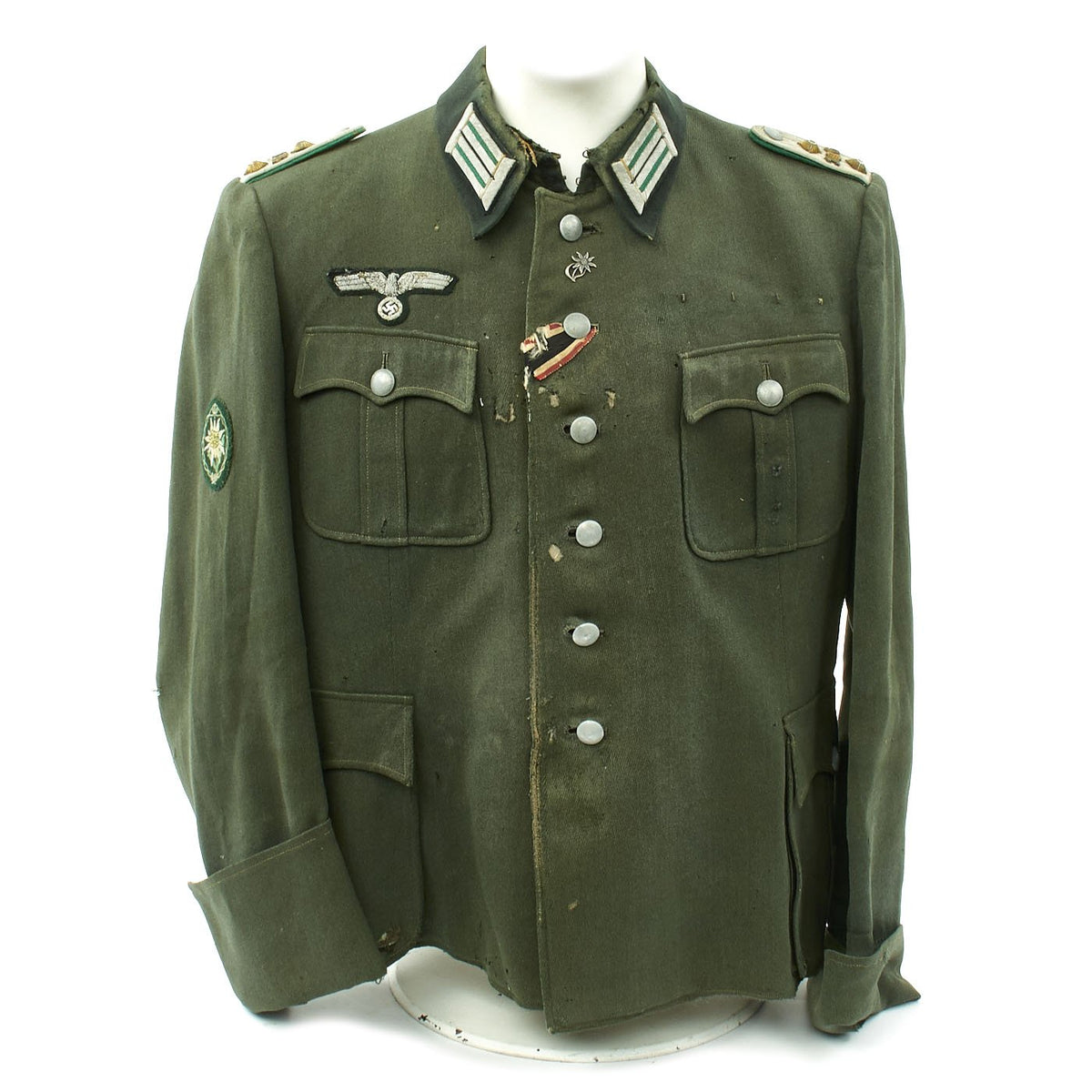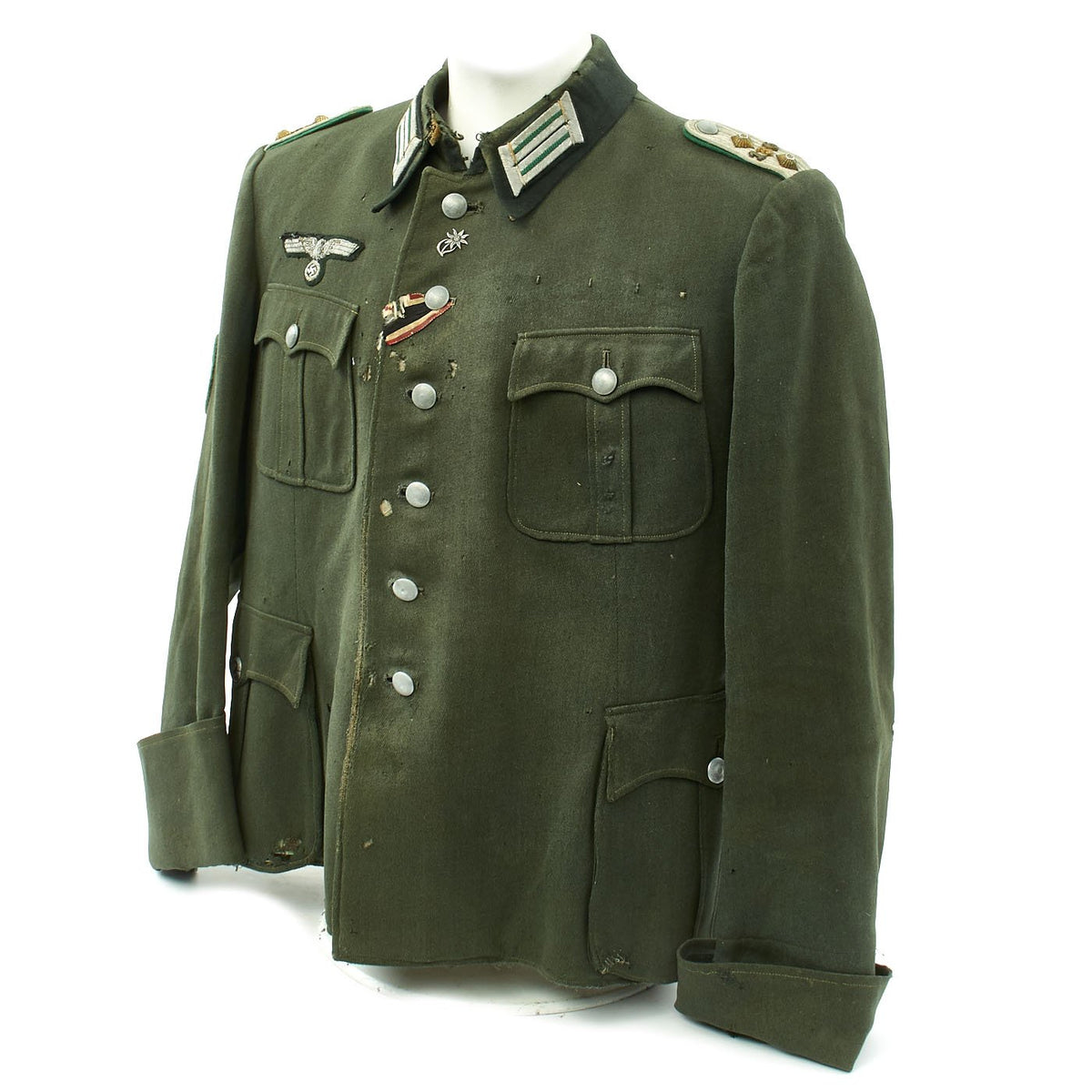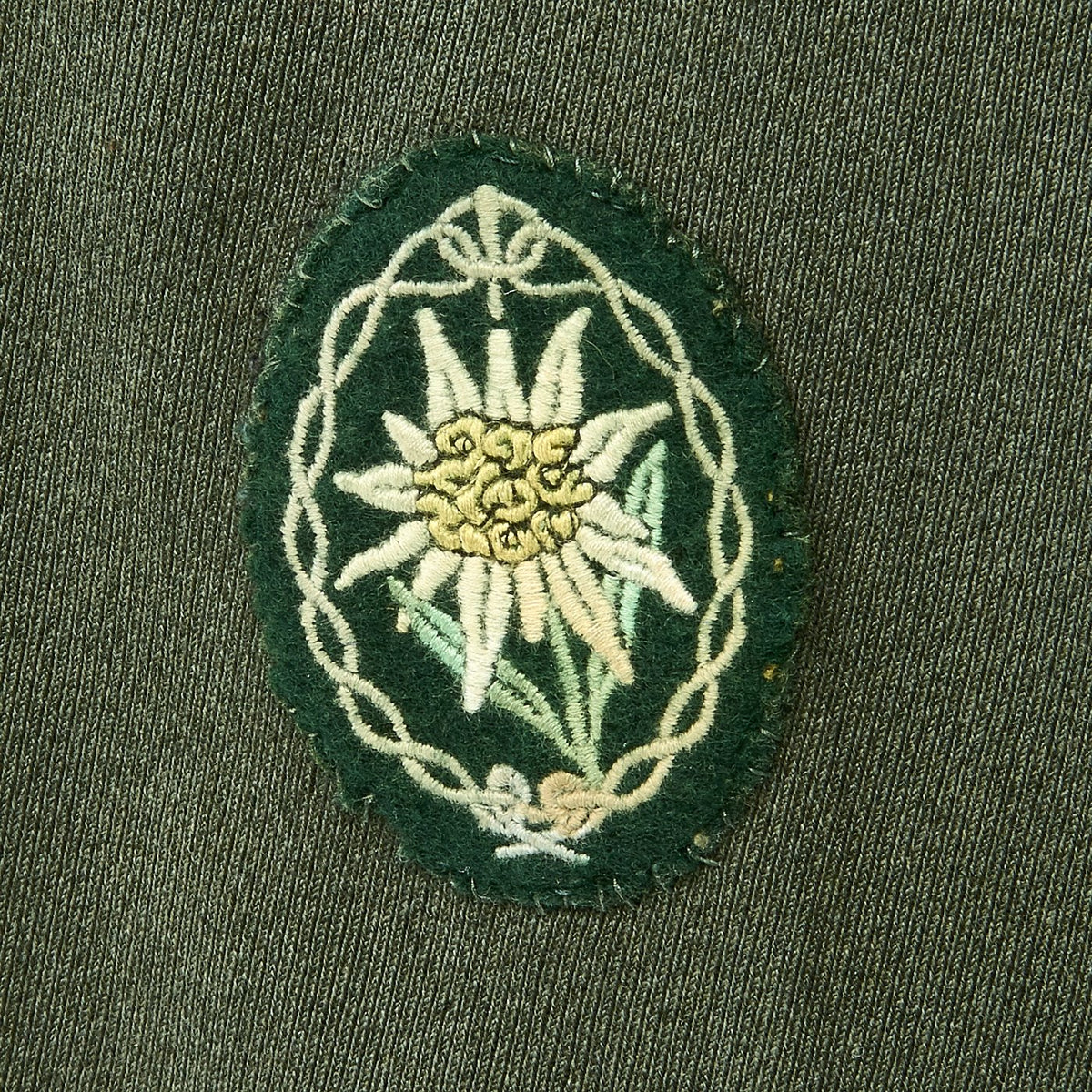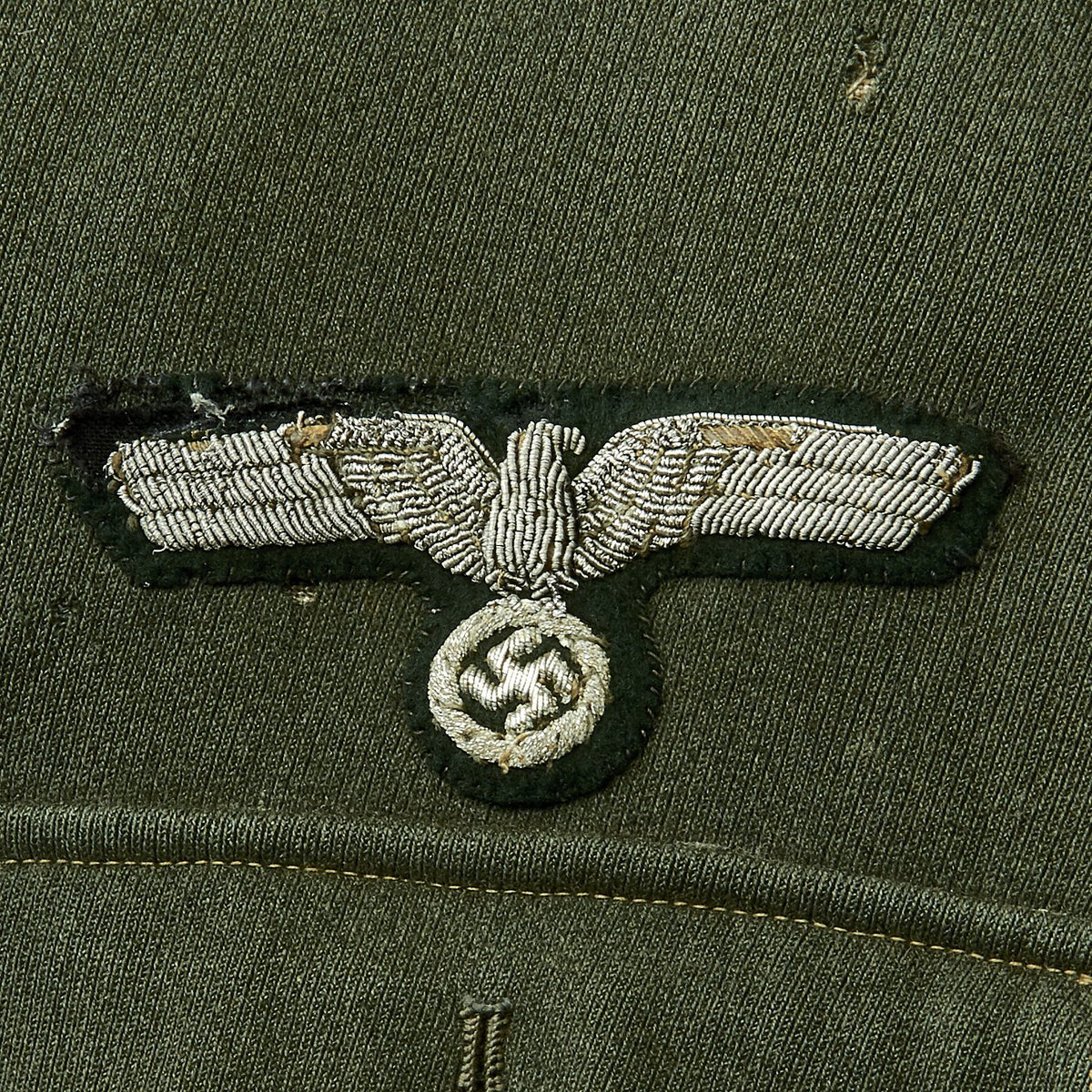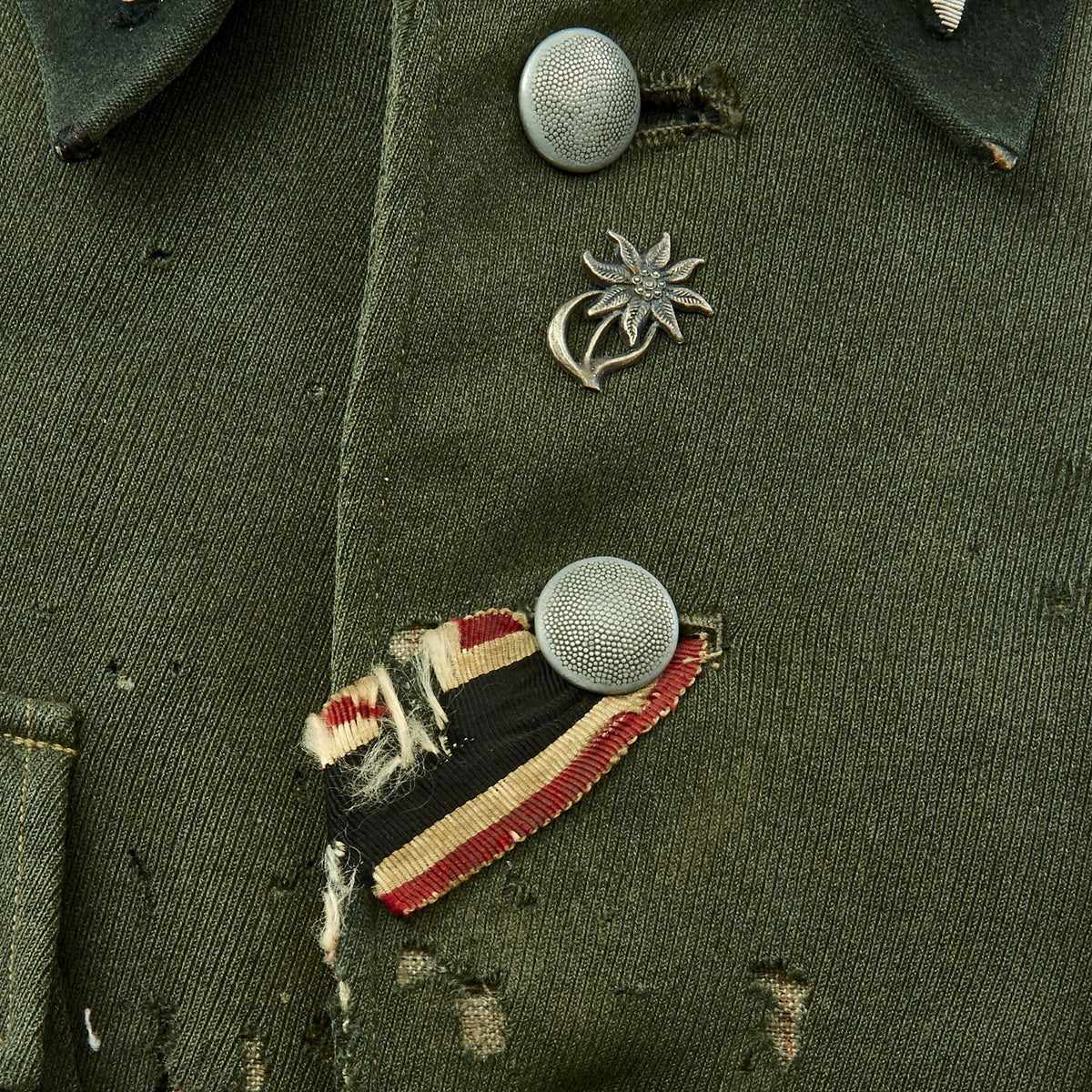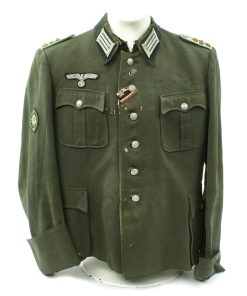Original German WWII Gebirgsjäger 136th Regiment 2nd Gebirgsjäger Division Officer M1940 Fedlbluse Uniform Tunic Original Items
$ 1.195,00 $ 298,75
Original Item: One-of-a-kind. The German Gebirgsjäger (Mountain Troop) from Gebirgsjäger-Regiment 136 (136th Regiment) 2.Gebirgs-Division (2nd Mountain Division). GJR136 was raised on 1 August 1938 from the Tyrol Jäger-Regiment of the Austrian Army in Innsbruck. The Regiment was put under the 2. Gebirgs-Division. The II.Bataillon / Gebirgsjäger-Regiment 140 was then put under GJR136 as its II. Bataillon and renamed it to II.Bataillon / Gebirgsjäger-Regiment 136 on 1 April 1940. The 2. Gebirgs-Division itself saw action in Poland in September 1939, followed by Norway from early 1940 until December 1941. Only elements of GJR136 were involved in the Norwegian campaign, noticeably about two company’s worth were parachute trained and jumped (one company each), on the airfield of Bardufoss and the town of Tromsø, just after the Norwegian capitulation in June 1940. These still classified as operational jumps and those involved received the parachute badge. From the summer of 1940 until June 1941 the regiment, along with the rest of Gebirgskorps Norwegen, were on garrison duties in Northern Norway. The entire Corps crossed the Finnish/Norwegian border on the 22 June 1941 and a week later crossed into the Soviet union with the aim of reaching Murmansk. That never happened, and by the autumn of 1941 both sides settled down to three years of static warfare about 30-40km short of Murmansk. On the 7 October 1944 the Soviets launched a massive assault against what was now called the XIX. Gebirgskorps made up of the 2nd and 6th Gebirgs-Division plus some smaller units. This offensive pushed the Germans into Norway over a period of three weeks until both sides broke contact 100 miles or so inside Norway. The 2. Gebirgs-Division was then withdrawn to the continent where it fought out the remainder of the war. The Gebirgsjäger-Regiment 136 was a part of 2. Gebirgs-Division throughout the war. The Regiment had one Ritterkreuzträger (Knight’s Cross holder): Hauptmann Otto Stampfer, who won the award on 23 July 1942, while serving in the III. Bataillon of the GJR136. In addition to Stampfer’s Ritterkreuz, the regiment had eight Deutsches Kreuz in Gold holders and one Ehrenblattspange holder.
This is a fine wool custom tailor made Model 1940 Feldbluse officer tunic for a Hauptmann (Captain) in the 136th Gebirgsjager Regiment. It features a beautiful embroidered Gebirgsjäger Edelweiss Sleeve Patch on right sleeve, Gebirgsjäger pin, Bullion embroidered eagle, company officer shoulder boards with two pips for the ranks of Hauptmann (captain) and 136 pins for the 136th regiment, a buttonhole ribbon that represents that he received iron cross 2nd class, multiple medal loops on the tunic indicate that he also received multiple medals for a ribbon bar, and wound badge or infantry assault badge. The tunic features a tailor’s label in the neck that reads A. Grissemann LANDECK-TIROL. The tunic is in worn condition (see photos) with areas of damage and loss, but it displays very well. It has six button to the front, all present, french cuffs (damage to left cuff) and four pocket from with scalloped flaps. Overall a wonderful genuine officer’s tunic from the legendary Gebirgsjäger!
Approximate Measurements:
Collar to shoulder: 10″
Shoulder to sleeve: 24″
Shoulder to shoulder: 19″
Chest width: 20″
Waist width: 20″
Hip width: 21″
Front length: 27″
Gebirgsjäger are the light infantry part of the alpine or mountain troops (Gebirgstruppe) of Germany, Austria and Switzerland. The word Jäger (meaning “hunter” or “huntsman”) is a characteristic term used for light-infantry or light-infantryman in a continental European military context.
During World War II the Wehrmacht and Waffen-SS raised a number of mountain infantry units.
An entire corps was formed in Norway by 1941. Its divisions were lightly equipped, with much of the transport provided by mules. These mountain infantry were equipped with fewer automatic weapons than regular infantry, however the MG 34 or MG 42 machine gunners were provided with more ammunition than their regular infantry counterparts. Mountain infantry were identified by the edelweiss insignia worn on their sleeves and their caps.
Mountain infantry participated in many battles, including Operation Weserübung, Operation Silver Fox, Operation Platinum Fox and Operation Arctic Fox, the operations in the Caucasus, the Gothic Line, the invasion of Crete and the battles in the Vosges region of France. Special equipment was made for them including the G33/40 mauser rifle based on the VZ.33 rifle.
The 2nd Mountain Division (German: 2. Gebirgs Division) was a Gebirgsjäger division of the German Army which served in World War II, mainly in the northernmost sector of the Eastern Front, near the Arctic. Formed in 1938, the division was disbanded at the end of the war in 1945.
Following the Anschluss, the annexation of Austria by NSDAP Germany in March 1938, the 2nd Mountain Division was formed on 1 April 1938, with personnel of the 6th Division of the Austrian Army. Based at Innsbruck, part of Wehrkreis XVIII (military district XVIII), most of its men were from the Salzburg and Tyrol region of Austria.
Commanded by Generalleutnant (Lieutenant General) Valentin Feurstein, it fought as part of Army Group South during the Invasion of Poland and then took part in Operation Weserübung, the Norwegian Campaign in 1940. It carried out a cross country march to rescue the 3rd Mountain Division, which was under siege from British forces during the Battles of Narvik.
The division moved into Lapland as part of Mountain Corps Norway in 1941, to participate in Operation Silberfuchs (Operation Silver Fox), the attack on the Soviet Arctic as part of Operation Barbarossa. It drove for Murmansk but was unsuccessful in the face of strong Soviet defence. It continued to serve in the Arctic region until late 1944, when the Finns negotiated the Moscow Armistice with the Soviet Union. The division had to withdraw to Norway, fighting off Soviet forces as it did so. Back in mainland Europe, its depleted infantry regiments were brought back up to strength.
In 1945, the division was transferred to the Western Front, where it fought in the Saar-Moselle Triangle against US troops. During this period, its commander, Generalleutnant Hans Degen, was wounded and had to be replaced by Generalleutnant Willibald Utz. While earlier in the war it was considered an elite unit, the 2nd Mountain Division was well below strength and combat effectiveness. It finished the war in Württemberg where Utz surrendered it to the Western Allies.
Commanding officers
The following officers commanded the division:
Generalleutnant Valentin Feurstein (1 April 1938 – 4 March 1941)
Generalleutnant Ernst Schlemmer (4 March 1941 – 2 March 1942)
Generalleutnant Georg Ritter von Hengl (2 March 1942 – 23 October 1943)
Generalleutnant Hans Degen (1 November 1943 – 6 February 1945)
Oberst (Colonel) Hans Roschmann (6 February 1945 – 9 February 1945)
Generalleutnant Willibald Utz (9 February 1945 – German capitulation)
Fast Shipping with Professional Packaging
Thanks to our longstanding association with UPS FedEx DHL, and other major international carriers, we are able to provide a range of shipping options. Our warehouse staff is expertly trained and will wrap your products according to our exact and precise specifications. Prior to shipping, your goods will be thoroughly examined and securely secured. We ship to thousands clients each day across multiple countries. This shows how we're dedicated to be the largest retailer on the internet. Warehouses and distribution centres can be located throughout Europe as well as the USA.
Note: Orders with more than one item will be assigned a processing date depending on the item.
Before shipping before shipping, we'll conduct a thorough inspection of the items you have ordered. Today, the majority of orders will be delivered within 48 hours. The delivery time will be between 3-7 days.
Returns
The stock is dynamic and we cannot completely manage it because multiple stakeholders are involved, including our factory and warehouse. So the actual stock may alter at any time. It's possible that you may not receive your order once the order has been made.
Our policy is valid for a period of 30 days. If you don't receive the product within 30 days, we are not able to issue a refund or an exchange.
You can only return an item if it is unused and in the same state as the day you received it. You must have the item in its original packaging.
Related products
Uncategorized
Uncategorized
Angolan Rebel 1970s era 60mm Inert Display Mortar from Angolan Civil War Original Items
Uncategorized
Uncategorized
Uncategorized
Uncategorized
Uncategorized
Uncategorized
Uncategorized
Uncategorized
Uncategorized
Uncategorized
Armoured Fighting Vehicles of the World: AFVs of World War One (Hardcover Book) New Made Items
Uncategorized
Uncategorized
Uncategorized
Armored Burgonet Helmet & Polearm from Scottish Castle Leith Hall Circa 1700 Original Items
Uncategorized
Band of Brothers ORIGINAL GERMAN WWII Le. F.H. 18 10.5cm ARTILLERY PIECE Original Items
Uncategorized
Uncategorized
Uncategorized
